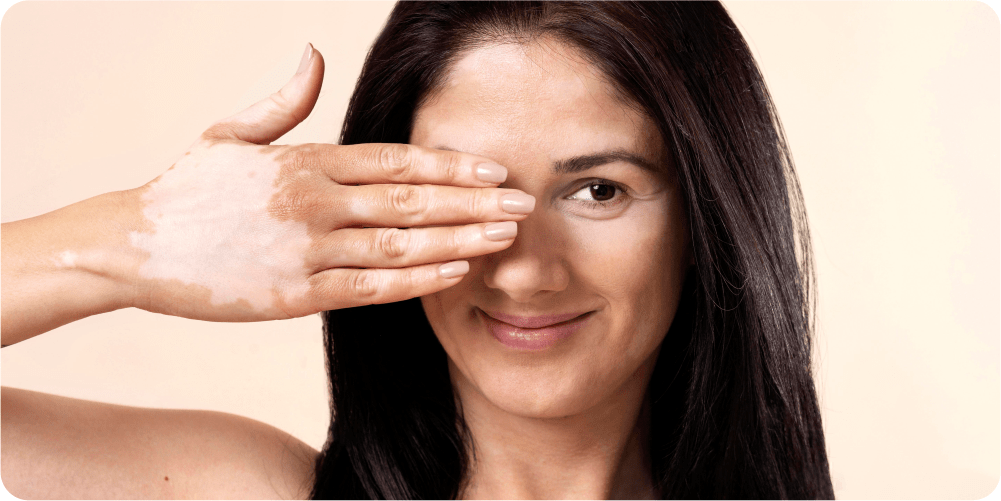
Vitiligo – Causes, Treatment, and Solutions
Many people dream of having white skin. But what if the skin is in white patches? Certainly, no one would want it to have. Yes, vitiligo is an undesirable skin condition to have. If you or your loved one is going through this condition, then it doesn’t have to steal away your life.
We a Epicorium are here to provide you with the best care and guidance for vitiligo.
What is Vitiligo?
Vitiligo is a skin condition in which skin loses pigmentation. This occurs when melanocytes or the cells that create skin pigment are destroyed. Vitiligo is present as white patches of skin on the body.
Read MoreVitiligo – Causes, Treatment, and Solutions
Many people dream of having white skin. But what if the skin is in white patches? Certainly, no one would want it to have. Yes, vitiligo is an undesirable skin condition to have. If you or your loved one is going through this condition, then it doesn’t have to steal away your life.
We a Epicorium are here to provide you with the best care and guidance for vitiligo.
What is Vitiligo?
Vitiligo is a skin condition in which skin loses pigmentation. This occurs when melanocytes or the cells that create skin pigment are destroyed. Vitiligo is present as white patches of skin on the body.
Whether you are in the early stages or not, it’s important to know about the treatment options for vitiligo.
What causes Vitiligo?
The pigment that gives our skin its normal skin color is called melanin which is prepared by melanocytes. It is believed that vitiligo is a disease where the body makes antibodies fighting against its own melanocytes. In doing so, it destroys them.
Person who has a history of this skin condition in family is more likely to get affected. Immunity also plays a crucial role in fighting against this skin disease. If someone has a defect in the immunity system, then the cells protecting our body itself can attack the melanocytes and result in vitiligo. Nerve damage is also associated with the cause of this skin condition. Certain people are allergic to chemicals and this may be the cause for melanocytes getting destroyed.
Vitiligo affects people of all skin color types. However, it is not contagious and does not spread on touching. Sometimes vitiligo is triggered by sunburn as well. While it is not necessary to undergo the treatment of vitiligo, nor it is life-threatening either, it is a social taboo. But even if you don’t go for the treatment, then it won’t belief threatening.
Symptoms of Vitiligo
If someone is suffering from vitiligo, then a light white patch will appear on the skin on any part of the body. It will gradually increase in size with time and become a well-defined patch with white hair on it. Vitiligo affects any part of the body but in most of patients, it appears on the lips, face, and fingers.
This skin condition can start at any age but around half of those who do get it, do so before the age of 20. The course of this skin condition is hard to predict but it progresses slowly.
There are periods of stability in between and they last for several years. The unique patches of skin slowly change in size and shape, while the skin around them is typically darker than normal. The hairs growing out of patches might be normal or it can turn into white too.
In some cases, the skin pigment color does come back like normal but it happens in rarest cases.
Types of Vitiligo
There are 2 broader types of Vitiligo called segmental and non-segmental vitiligo.
Segmental Vitiligo
In this type, one half or side of the body is affected and it doesn’t spread beyond that. This type is known to have good results with treatment.
Non-Segmental Vitiligo
In this type, if there is white patch around one eye or one hand, then the other eye or other hand also has white patch. It is most commonly found on feet, hands, eyes, arms, and elbows and is more generalized in nature. This type of vitiligo spreads less rapidly as compared to the other type but it is also more difficult to treat.
Can we cure Vitiligo?
Vitiligo goes away in rare cases and a few treatments might slow down its progress. Most of the patients do respond to the vitiligo treatment but duration might vary between individuals and also with patch.
Vitiligo Treatment
There are two steps in treatment which includes first to stop the disease progression and second to stimulate pigment production. We at Epicorium strive to provide the best possible treatment to our patients.
Pigment can be brought back by:
PUVA Treatment: In PUVA treatment, you will be given a tablet to take by mouth, and then be exposed to Ultra Violet light.
Surgical procedures: This can be performed when the disease state is stable i.e. there should be no occurrence of new patches. There are various modes of surgeries like Miniature punch grafting (MPG), Suction Blister grafting (SBG), Epidermal cell suspension (ECS) which will be done based on the extent of the patch.
Minimum 3 months resting should be taken after the surgery to get good response.
Tattoo: Tattooing the white patch can be done to match the surrounding skin. This requires multiple sessions and is best for a faster temporary fix of the patch.
Removing the remaining pigment: Finally, if the vitiligo has spread widely over body, it may be easier to get rid of the small amounts of pigment that are still left using a bleaching chemical.
The white colour gained in this way may be more acceptable, but the social implications of it must be discussed before this treatment is used.
What can you do to treat Vitiligo skin?
Remember that the sun exposure should be avoided for long time. The pale areas on your skin will burn easily in the sun and tanning will make the contrast between the skin more obvious.
Keep your self-esteem high by making your skin look as normal as possible. Learn the right ways to hide the white areas with makeup products. Good modern ones come in a range of colours, and sizes. They are hard to wipe off, and can be waterproof.
Don’t change your diet – this never does much good.
Visit our dermatologists if any white patch over the body looks suspicious. Treat your skin as early as possible for the best response.
FAQs
Treatment results will vary by person and type of vitiligo. The rule of thumb is that you will need to allow at least 3 to 6 months before you begin to see results from any treatment, and you may expect satisfactory results within 12-18 months.
It’s important to remember there are multiple factors involved in vitiligo onset, including genetic predisposition, living and working environments, and exposure to certain chemicals. Some products may be harmful for some patients but not others.
A well-trained dermatologist should be able to diagnose vitiligo and distinguish it from contact leukoderma or more than twenty other conditions with similar skin appearance based on physical examination, assisted with a Wood’s lamp.
Occasionally, your doctor may recommend some tests to get more information about a possible autoimmune response related to vitiligo or associated diseases.
Vitiligo is a common skin condition with characteristic milky white patches of irregular shape. However, several other skin conditions exhibit similar symptoms that can lead to a misdiagnosis of vitiligo.
Broadly speaking, loss of skin pigmentation is called leukoderma. Vitiligo is a specific type of leukoderma and is often, though incorrectly, used interchangeably with the term leukoderma.



